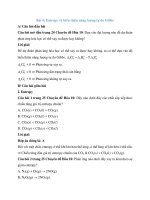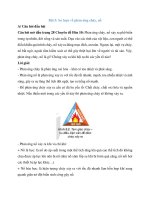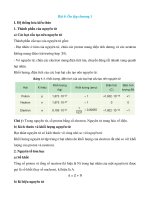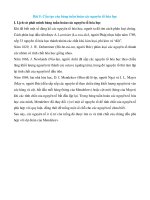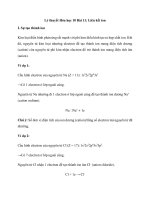Bài giảng 1,2 chuyên đề Phenol và Alcohol (hóa hữu cơ 2)
Bạn đang xem bản rút gọn của tài liệu. Xem và tải ngay bản đầy đủ của tài liệu tại đây (5.47 MB, 55 trang )
Lecture 1
ALCOHOLS AND PHENOLS
1
Lecture 1
ALCOHOLS AND PHENOLS
• Acidity
• Alcohol preparation
• Alcohol reactions (substitution, elimination, forming
ester and oxidation)
• Group Protection in organic synthesis
• Phenol synthesis and reaction (overview)
READING: Chapter 17 (McMurry)
2
Alcohols and Phenols
Saturated C-OH
Phenyl C-OH
Double bond C-OH
Naming Alcohols and Phenols: (check textbook)
3
Acidity
4
Acidity
• Alkoxide (RO-) solvation by water ! energetically favored
pKa = 15.54
Forms Methoxide
pKa = 18.00
Forms tert-Butoxide
(steric hindrance)
• Electron-withdrawing groups make an alcohol a stronger acid by
stabilizing the conjugate base
5
Acidity
• Phenols are more acidic than alcohols due to resonance
stabilization of the phenoxide ion
• Phenols with an electron-withdrawing substituent are more acidic
and phenols with an electron-donating substituent are less acidic
6
Example
• Rank the following substances in order of increasing acidity
a) (CH3)2CHOH, HC≡CH, (CF3)2CHOH, CH3OH
b) Benzyl alcohol, phenol, p-hydroxybenzoic acid
7
Example
• Rank the following substances in order of increasing acidity
a) (CH3)2CHOH, HC≡CH, (CF3)2CHOH, CH3OH
b) Benzyl alcohol, phenol, p-hydroxybenzoic acid
• Solution:
Least acidic
Most acidic
a) HC≡CH < (CH3)2CHOH < CH3OH < (CF3)2CHOH
b) Benzyl alcohol < phenol < p-hydroxybenzoic acid
8
Alkoxides
(RO-)
synthesis
9
Preparation & Reaction of Alcohols
1
0
Alcohols Preparation From alkenes
(review Alkenes chapter)
10
Alcohols Preparation from C=O Reduction
• Reduction of a carbonyl compound gives an alcohol
• Addition of H to a C═O bond
• Reduction of aldehydes gives primary alcohols
• Reduction of ketones gives secondary alcohols
12
Alcohols Preparation from C=O Reduction
Reagent: Sodium Borohydride (NaBH4): not sensitive to moisture
13
Alcohols Preparation: Mechanism of Reduction
• Addition of a nucleophilic hydride ion to the
positively polarized, electrophilic carbon atom of
the carbonyl group
• Alkoxide ion is protonated to yield the alcohol
product
14
Reductions in Living Organisms
• Carried out by either of the coenzymes, NADH or NADPH
15
Alcohols Preparation:
Reduction of Carboxylic Acids and Esters
• Carboxylic acids and esters are reduced to give primary alcohols
• LiAlH4 is used because NaBH4 is not effective
16
Example
• What carbonyl compounds give the following
alcohol on reduction with LiAlH4?
17
Example
• What carbonyl compounds give the following
alcohol on reduction with LiAlH4?
• Solution:
• Benzyl alcohol may be the reduction product of an
aldehyde, a carboxylic acid, or an ester
18
Alcohols Preparation from Carbonyl
Compounds: Grignard Reagents
• Organohalides react with magnesium to produce Grignard reagents,
RMgX
• Grignard reagents react with carbonyl compounds to yield alcohols
19
Mechanism of the Addition of a Grignard
Reagent
• Grignard reagents act as nucleophilic carbon anions
• Intermediate alkoxide is protonated to produce the alcohol
20
Alcohols
Preparation:
Grignard
Reagents
21
Alcohols Preparation from Carbonyl Compounds:
Grignard Reagents
• Esters react with Grignard reagents to yield tertiary alcohols
• Grignard reagents do not give addition products with carboxylic acids
• Acidic carboxyl hydrogen reacts with the basic Grignard reagent
to yield a hydrocarbon and the magnesium salt of the acid
22
Limitations of Grignard Reagents
• If other reactive functional groups are present in the same molecule,
Grignard reagent cannot be prepared from an organohalide
20
Example
• Show the products obtained from addition of
methylmagnesium bromide to the following
compounds
a) Cyclopentanone
b) Benzophenone
24
Example
• Show the products obtained from addition of
methylmagnesium bromide to the following
compounds
a) Cyclopentanone
b) Benzophenone
• Solution:
a)
b)
25
